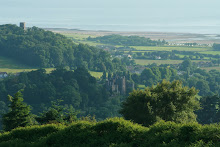Following the relatively dry, cold weather recently we have finally been able to carry out controlled burning- or swaling as it is known locally- just in time to avoid birds nesting season. The site, which is managed directly by The Crown Estate, is called Hopcott Common, to the south of Minehead and is one of the country's last refuges for the Heath Fritillary butterfly. This year, through the Exmoor National Park 'moorkeeper' project we, and the other landowners on Wootton Ridge have pro-actively cutting scrub and burning to keep it from encroaching further in order for the food plants of the Heath Frit to be able to grow more easily. As a result the populations of Heath Frits are doing well on Hopcott, but it is an ongoing effort to keep the scrub at bay. Though it may look destructive, Swaling if managed correctly can be a very effective way of controlling scrub, and the desired vegetation, such as heather and bilberry, will soon recover, and even be re-invigorated as a result of the overlying scrub being taken back.
Thursday, 28 March 2013
Monday, 25 March 2013
Forests For the Future Launch
On friday the 22nd March, 60 children and teachers from Westover School, Brigwater and Alison Nimmo, The Crown Estate's Chief Executive joined us for an afternoon of forest fun to celebrate the national launch of the Forests for the Future education pack and online resource. Despite the weather we had a great time building dens, seeing how many 'hugs' wide the tallest tree in England is (12 if you were wondering!) and using all 60 of the visitors to measure out the length of the tallest tree on the ground- it was pure chance that 60 people joined us, and that the tree is 60m tall! Now we have officially launched the pack we are looking at further promoting it, and so will be looking to work with Local Education Authorities to train teachers on how to use the pack and work through the activities. Please feel free to contact us for more info.
Thursday, 14 March 2013
Tales from Withycombe wood- early march
Dunster Estate volunteers have been coppicing in Withycombe Wood again, after a brief visit to Three Acre Covert near Watchet at the end of feb to undertake raking of cut grass to encourage the extremely rare Hairy Mallow, which exists there and virtually nowhere else! Today we continued with the work of coppicing the overgrown hazel stools and generally opening things up in there- it is really starting to make a difference and we will soon be seeing how the coppiced stools regenerate. The spectacular bluebells in Withycombe Wood aren't quite there yet, but as you can see from the elm shoots in the picture the first signs of spring are on their way- despite the biting wind!
Subscribe to:
Comments (Atom)


